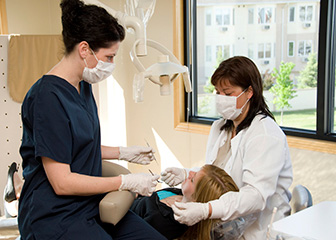Summary

| Quick Facts: Dental Assistants | |
|---|---|
|
$33,470 per year
$16.09 per hour |
|
| Postsecondary non-degree award | |
| None | |
| None | |
| 297,200 | |
| 31% (Much faster than average) | |
| 91,600 | |
What Dental Assistants Do
Dental assistants have many tasks, ranging from patient care to record keeping, in a dental office. Their duties vary by state and by the dentists’ offices where they work.
Work Environment
Almost all dental assistants work in dentists' offices. More than half work full time.
How to Become a Dental Assistant
There are several possible paths to becoming a dental assistant. Some states require assistants to graduate from an accredited program and possibly pass a state exam. In other states, there are no formal educational requirements. Dental assistants who do not have formal education in dental assisting may learn their duties through on-the-job training. The dentist or other dental assistants in the office teach the new assistant dental terminology, the names of the instruments, how to do daily tasks, how to interact with patients, and other activities necessary to help keep the dental office running smoothly. Most states regulate what dental assistants may do, but that varies by state.
Pay
The median annual wage of dental assistants was $33,470 in May 2010.
Job Outlook
Employment of dental assistants is expected to grow by 31 percent from 2010 to 2020, much faster than the average for all occupations. Ongoing research linking oral health and general health will continue to increase the demand for preventive dental services. As dental practices grow, more dental assistants will be needed.
Similar Occupations
Compare the job duties, education, job growth, and pay of dental assistants with similar occupations.
O*NET
O*NET provides comprehensive information on key characteristics of workers and occupations.
Contacts for More Information
Learn more about dental assistants by contacting these additional resources.








